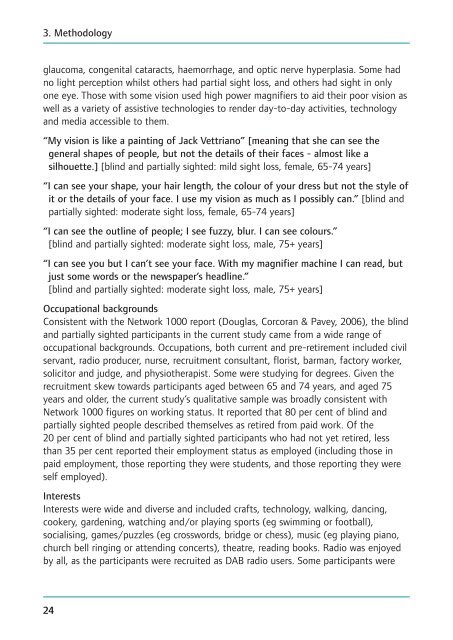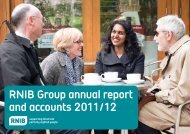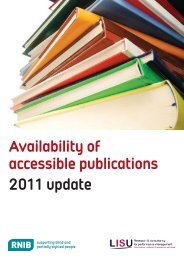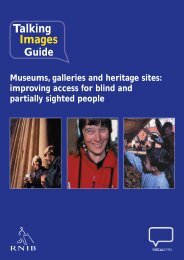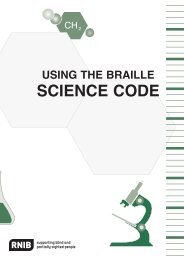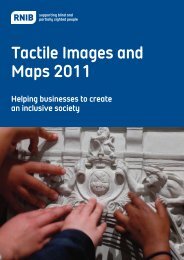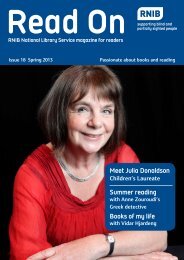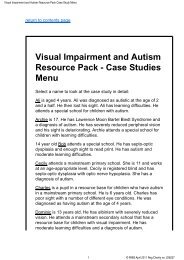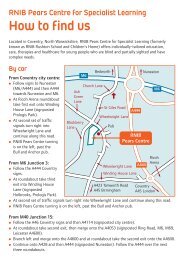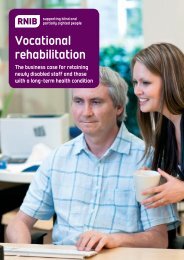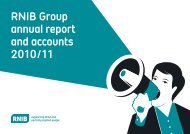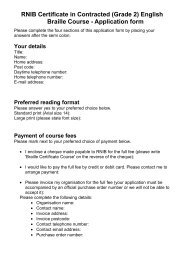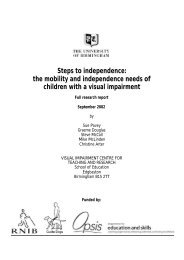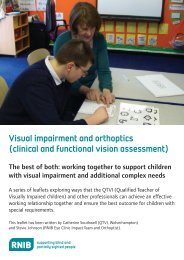Download Complete Report (PDF 1.19mb) - RNIB
Download Complete Report (PDF 1.19mb) - RNIB
Download Complete Report (PDF 1.19mb) - RNIB
Create successful ePaper yourself
Turn your PDF publications into a flip-book with our unique Google optimized e-Paper software.
3. Methodology<br />
glaucoma, congenital cataracts, haemorrhage, and optic nerve hyperplasia. Some had<br />
no light perception whilst others had partial sight loss, and others had sight in only<br />
one eye. Those with some vision used high power magnifiers to aid their poor vision as<br />
well as a variety of assistive technologies to render day-to-day activities, technology<br />
and media accessible to them.<br />
“My vision is like a painting of Jack Vettriano” [meaning that she can see the<br />
general shapes of people, but not the details of their faces - almost like a<br />
silhouette.] [blind and partially sighted: mild sight loss, female, 65-74 years]<br />
“I can see your shape, your hair length, the colour of your dress but not the style of<br />
it or the details of your face. I use my vision as much as I possibly can.” [blind and<br />
partially sighted: moderate sight loss, female, 65-74 years]<br />
“I can see the outline of people; I see fuzzy, blur. I can see colours.”<br />
[blind and partially sighted: moderate sight loss, male, 75+ years]<br />
“I can see you but I can’t see your face. With my magnifier machine I can read, but<br />
just some words or the newspaper’s headline.”<br />
[blind and partially sighted: moderate sight loss, male, 75+ years]<br />
Occupational backgrounds<br />
Consistent with the Network 1000 report (Douglas, Corcoran & Pavey, 2006), the blind<br />
and partially sighted participants in the current study came from a wide range of<br />
occupational backgrounds. Occupations, both current and pre-retirement included civil<br />
servant, radio producer, nurse, recruitment consultant, florist, barman, factory worker,<br />
solicitor and judge, and physiotherapist. Some were studying for degrees. Given the<br />
recruitment skew towards participants aged between 65 and 74 years, and aged 75<br />
years and older, the current study’s qualitative sample was broadly consistent with<br />
Network 1000 figures on working status. It reported that 80 per cent of blind and<br />
partially sighted people described themselves as retired from paid work. Of the<br />
20 per cent of blind and partially sighted participants who had not yet retired, less<br />
than 35 per cent reported their employment status as employed (including those in<br />
paid employment, those reporting they were students, and those reporting they were<br />
self employed).<br />
Interests<br />
Interests were wide and diverse and included crafts, technology, walking, dancing,<br />
cookery, gardening, watching and/or playing sports (eg swimming or football),<br />
socialising, games/puzzles (eg crosswords, bridge or chess), music (eg playing piano,<br />
church bell ringing or attending concerts), theatre, reading books. Radio was enjoyed<br />
by all, as the participants were recruited as DAB radio users. Some participants were<br />
24


